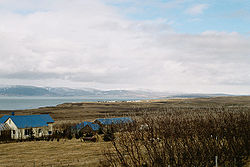Búðardalur
| Búðardalur | ||
|---|---|---|
|
|
||
| Coordinates | 65 ° 6 ′ N , 21 ° 46 ′ W | |
| Basic data | ||
| Country | Iceland | |
| Vesturland | ||
| ISO 3166-2 | IS-3 | |
| local community | Dalabyggð | |
| Residents | 269 (January 1, 2019) | |
Búðardalur is the capital of the Dalabyggð municipality in the Vesturland region in western Iceland . On January 1, 2019, the place had 269 inhabitants.
geography
The place Búðardalur is located on Hvammsfjörður at the northeast end of the Snæfellsnes peninsula . Haukadalur is located south of Búðardalur .
history
The place is located on old settlement land and is already mentioned in the Laxdæla saga , which takes place largely on the soil of the municipality, namely in Laxárdalur . The name of the main town is derived from a passage in the saga, which actually comes from the mixture of tents and low walls known to the Vikings, known as búðir .
Búðardalur has been known for centuries as a trading center, which fits the current meaning of the name, shop valley .
In 1899 Búðardalur officially received the trading rights when a certain Bogi Sigurðsson settled down as a local merchant. An old house from that time still exists, but has since been transferred to Selfoss .
Economy and Infrastructure
The village is a small service center for the residents of the area. Here you will find a kindergarten, comprehensive school and health center (isl. Heilsugæslustöð ) next to the administrative facilities of the Dalabyggð municipality . There are also shops and a gas station.
In addition to smaller craft businesses, a dairy is a major local employer.
In Búðardalur there is increasing focus on tourism with the expansion of guest houses, restaurants and a museum.
Culture and sights
Leifsbúð by the harbor houses a museum about Leifur Eiríksson .
Nearby is Eiríksstaðir in Haukadalur , the former seat of Erik the Red , who set out for Greenland from here . A visitor center and a small museum are dedicated to him, especially from this period.
Population development
The area is affected by rural exodus.
- 2011: 248 inhabitants
- 1988: 303 inhabitants
Web links
See also
Individual evidence
- ↑ a b c T. Einarsson, H. Magnússon (eds.): Íslandshandbókin. Náttúra, saga og sérkenni. 1. bindi. Örn og Örlygur, Reykjavík 1989, p. 188.
- ↑ cf. HU Schmid: Dictionary Icelandic - German. Buske, Hamburg 2011, ISBN 978-3-87548-596-7 , pp. 34, 36.
- ^ Hagstofa (Stat. Office of Iceland) (Icelandic); Accessed August 9, 2011

